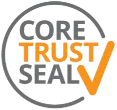Frequently Asked Questions
General FAQ
- What does the Digital Repository of Ireland (DRI) do?
The Digital Repository of Ireland (DRI) is a CoreTrustSeal-certified trustworthy digital repository for the preservation of Ireland’s humanities, cultural heritage, and social sciences digital data for long-term discovery and access. Find out more about what we do on our About page.
- What is a Repository?
A repository is an online archive where organisations and researchers can deposit digitised and born-digital research outputs and cultural heritage data and provide (open) access to them. Repositories help manage and provide access to digital data. As well as providing stewardship of the data, they also contribute to the long-term preservation of digital assets. (See European Research Council).
- What is the CoreTrustSeal?
CoreTrustSeal offers data repositories a core level certification based on the Core Trustworthy Data Repositories Requirements. This universal catalogue of requirements reflects the core characteristics of trustworthy data repositories.
- What is digital preservation?
Digital preservation is the ‘active management of digital content over time to ensure its ongoing access’ (Library of Congress). Find out more on our dedicated digital preservation page.
- Why do we need digital preservation?
Digital content is fragile: file formats can change, technologies change, websites can be taken down, user needs evolve, and hardware can become obsolete. Without active management, digital content is at risk of becoming inaccessible due to factors like format obsolescence, media failure, or barriers to discoverability. The ultimate aim of digital preservation is to provide sustained access by reducing risks to digital content.
- What is a digital object?
A DRI digital object refers to metadata, and the associated digital asset e.g. an image, a document, an audio file etc. A digital object without assets, i.e., metadata only, is also a valid digital object.
- How is data/content on DRI organised?
All content in DRI is organised into Collections, which can optionally be divided into subcollections. Each object can only have one parent (sub-)collection.
- What is a DOI?
A digital object identifier (DOI) is a persistent identifier for a digital object. A DOI provides an unchanging link to an open, web accessible page; in the case of DRI, the digital object within the DRI Repository.
- What is a PID?
A persistent identifier, or PID, is a long-lasting reference to a digital resource. An identifier is a label which gives a unique name to an entity: a person, place, or thing. Unlike URLs, which may break, a persistent identifier reliably points to a digital entity (ORCiD). PIDs are a key infrastructure supporting open research.
- What is a DRI Member?
A DRI member is an organisation which has been assessed for ingesting content into the DRI Repository. DRI members ensure that digital objects deposited meet the Repository’s documented standards (including but not limited to those pertaining to licensing, metadata and formats). Members also abide by all DRI agreements (e.g. Organisational Manager Agreement, Deposit Agreements).
- How do I get access to the DRI API?
To get access to the DRI Application Programming Interface (API), you must first be registered with DRI. You must then apply for an API key by contacting dri@ria.ie.
- How does DRI cite data?
DRI automatically generates and displays citations to the digital objects it holds, these citations are in the following format: Creator (Date) Title, Publisher, Digital Repository of Ireland [Distributor], NAME [Depositing Institution]. DOI
- How do I generate a DRI citation?
When you are viewing an object or collection, you can generate a DRI citation by clicking “Cite” under the “Object Tools” menu in the sidebar.
- How much data can DRI hold?
The DRI utilises “Elastic Storage”, which can be expanded as required.
- What is an Orphan Work?
An Orphan Work is a work protected by copyright, where the rightsholder cannot be determined and/or contacted.
User FAQ
- What is a DRI Collection?
A DRI collection is a group of digital objects. A collection may contain different types of objects e.g. images, audio, text, metadata. A collection is an aggregation of digital objects which may be linked by subject, location, ownership, etc.
- What is metadata?
Metadata is data about data. The metadata of an object describes and explains the related digital or physical asset.
- What type of data can I access in DRI?
DRI gives access to Ireland’s humanities, social sciences, and cultural heritage data. Please see our Collection Policy for more information on the types of data, digital assets, and collections which the DRI aims to preserve.
- Can I reuse the data I discover on DRI?
The reuse of data discovered on the DRI is dependent on the licence that is assigned to the data. You can get more information on what each type of licence means in the DRI Copyright, Licensing, and Open Access Factsheet.
- Who can use DRI?
DRI can be used by anyone, including but not limited to, primary and second level pupils, undergraduate and postgraduate students, educators and academic researchers, historians, local interest groups, and public researchers with a specific interest in Irish cultural heritage.
- Do I have to register to use DRI?
You don’t have to register to use DRI, however if you sign up and register and agree with our terms and conditions you can gain access to an expanded number of collections, or apply for access to more restricted collections. Users can create an account on DRI for free in the DRI Workspace.
- How do I narrow my search results?
When searching in DRI, you can filter your search results by using facets. Facets can be found under the “Refine your search” feature. You can facet on: Creation Date, Published Date, Licence, Subjects, Subject (Temporal), Places, Names, Language, Media type, Organisation and Collection.
- Can I use boolean logic in my search terms?
Yes, the Repository can be searched using boolean logic. To do so, you can include the words “AND”, “OR”, “NOT”, and “AND NOT” in your free text query.
- How can I carry out an advanced search on DRI?
DRI uses the Lucene Query Syntax for searching. You can make use of various different types of queries including, keyword matching, wildcard matching, and proximity matching. For more details on how to use these types of queries, please see the Lucene guide.
- How do I bookmark an object or collection?
When you are viewing an object or collection, you can bookmark an object or collection by pressing “Bookmark Object” or “Bookmark Collection” respectively, under the “Object Tools” menu in the sidebar.
- Can I share content on social media?
You can share openly accessible content and all metadata on social media platforms.
Depositor FAQ
- What types of files can I ingest into the DRI?
You can ingest any file format into DRI, however not all file formats will be rendered on the Repository website. Please see DRI File Formats Factsheet on the recommended file formats for ingestion into DRI.
- Can I ingest my data into DRI?
You should first evaluate your collection. For help doing this you should look at the DRI Life-Cycle Step 1: Evaluate your Collection.
- How do I need to prepare my data for DRI?
You should look at the DRI Life-Cycle Step 2: Data Preparation for guidelines on how you can prepare your data for DRI.
- Where can I get help to prepare my data?
The DRI Life-Cycle resources will help you prepare your data for DRI. In addition, DRI offer a range of training sessions, so keep an eye on our events and our Twitter account @dri_ireland for information on upcoming events.
- Will I retain ownership of my data after ingesting?
The original creators will retain ownership, copyright, and associated intellectual property rights of all digital objects ingested into DRI.
- Will DRI allow me to change or add to my collections after they have been published?
Yes, you can change your collection-level metadata, and you can also add new objects to your collections.
- Can I decide who sees my data on DRI?
Yes, you can set restrictions on your data in DRI.
- How secure is DRI?
Details of our security procedures are detailed in our Security Policy. This Security Policy is reviewed regularly to ensure that our security procedures remain robust and comprehensive as the DRI’s technology choices and policies evolve. To request a copy of our Security Policy, please contact dri@ria.ie.
- Will DRI preserve my data, without my input, forever?
If DRI ceases as a live repository, content will be returned to the owner in the same (or enhanced) quality as it was received.
- What will DRI allow others to do with my data?
This is dependent on the type of licence you attach to your data. For more information on licences and copyright, please see our fact sheet on Copyright, Licensing and Open Access.
- If I create a collection and assign a CC license, can this licence be changed?
Once you assign a CC licence to anything, you cannot revoke the licence. However, you can assign a less restrictive CC license, but you cannot become more restrictive. This is in accordance with Creative Commons guidelines.
- What if the surrogate for my PDF isn’t as I expected, or hasn’t been generated at all?
If PDF surrogates don’t generate, or they are not as you expected, at the review stage then check the “File Details” (under “Asset Tools”) and make sure the PDF is well formed. If there is a problem with the PDF try opening it in a PDF reader and saving it again. You can then reingest the PDF using the “Replace Master Asset” feature under “File Details” (under “Asset Tools”).
- Are there different levels of users in the depositing process?
Yes, DRI have developed a user hierarchy to facilitate different institutional structures and allow organisations to distribute the work required to deposit data into the DRI repository. There are currently three different administrative users; Organisational Manager, Collection Manager, and Edit User. For more information on permissions attached to each of these users, please see the How To DRI: Understanding Administrative Roles.
DRI is funded by the Department of Further and Higher Education, Research, Innovation and Science (DFHERIS) via the Higher Education Authority (HEA).



